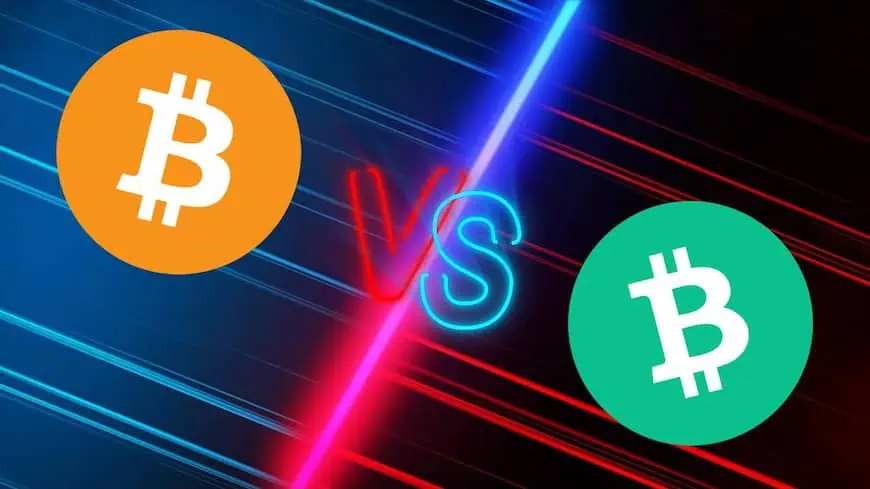Bitcoin (BTC) and Bitcoin Cash (BCH) share many similarities. Bitcoin, often regarded as digital gold or “gold 2.0,” is the pioneering cryptocurrency, functioning as a store of value and an inflation hedge. On the other side, Bitcoin Cash aims to be digital cash, emphasizing its supporters’ desire for it to be inexpensive and user-friendly. Understanding the difference between Bitcoin and Bitcoin Cash is crucial for navigating the nuances of these two prominent cryptocurrencies.

Bitcoin
In July 2017, a significant upgrade took place in the Bitcoin community. Mining pools and companies representing a substantial 80% to 90% of Bitcoin computing power voted to introduce a technology called segregated witness (SegWit). So, what does SegWit do? It tackled a key issue by making each block’s verification data smaller. This was achieved by taking signature data from the block that needed processing in every transaction and attaching it to an extended block.
The signature data was estimated to make up around 65% of the data processed in each block. So, by moving it to a separate block, the overall efficiency of the Bitcoin network got a significant boost. By September 2017, research from cryptocurrency exchange BitMEX revealed that the implementation of SegWit had successfully increased the block size. This was a crucial step forward in improving the scalability and transaction processing efficiency of the Bitcoin network.
Bitcoin Cash
Bitcoin Cash is different. It was initiated by Bitcoin miners and developers who shared concerns about the future of cryptocurrency and its ability to scale effectively. They believed that SegWit didn’t meaningfully address the scalability issue and deviated from the original roadmap outlined by Satoshi Nakamoto, the mysterious figure behind the concept of blockchain technology.
In August 2017, a group of miners and developers created a new blockchain and currency: Bitcoin Cash (BCH). Unlike its predecessor, BCH operates on its blockchain. Apart from Bitcoin, Bitcoin Cash boasts an increased block size of 8MB. Later on, the block size limit was later bumped up to 32 MB in 2018.
The Bitcoin Scaling: Unraveling the Debate
Bitcoin has faced persistent questions about its ability to scale effectively and become a global currency. While the use of blockchain technology ensures decentralization and censorship resistance, it comes with a significant tradeoff: the transaction throughput or the volume of transactions the Bitcoin blockchain can process per second. The current state of the Bitcoin blockchain manages around seven transactions per second, a noticeable gap that became more pronounced as the network’s user base expanded.
In contrast to traditional payment systems, like Visa, which handles a remarkable 150 million transactions daily, averaging 1,700 transactions per second with the capacity to peak at 24,000 transactions per second, the current state of the Bitcoin blockchain reveals a significant disparity. The blockchain, limited to 1 MB of data per block, manages only around seven transactions per second. In response to Bitcoin’s scalability hurdles, the community proposed two primary solutions.
One advocated for an increase in the block size to facilitate more transactions per block, while another proposed maintaining a 1 MB block size and implementing scalability through layer-two solutions. The escalating debate over maintaining a 1 MB block size and implementing scalability through layer-two solutions intensified over time. Disagreements deepened, and accusations of manipulation were hurled within the community. Eventually, this growing division reached a critical breaking point, leading to a split in the blockchain. This schism became necessary to address fundamental differences and set the stage for the pursuit of distinct paths in the future development of Bitcoin.
The Bitcoin Cash hard fork
On May 23, 2017, the Bitcoin Cash hard fork became a pivotal moment, as influential figures, including Bitcoin business owners and miners controlling over 85% of the network’s computing power, held a closed-door meeting to shape BTC’s future. The outcome was the SegWit2x upgrade proposal.
SegWit2x aimed to boost Bitcoin’s scalability by implementing Segregated Witness (SegWit), a protocol segregating data from the limited block space and adjusting block sizes to 2 MB through a hard fork. However, community opposition arose, with critics arguing the main codebase’s inadequate representation and perceiving the proposal as centralizing.
In the scaling debate, proponents of small blocks resisted an increase, fearing blockchain size inflation and potential centralization. Conversely, advocates of larger blocks sought a quick solution, fearing rising transaction fees’ adverse effects on BTC’s growth. This clash led to the hard fork and the emergence of Bitcoin Cash as a separate cryptocurrency.
How these two currencies differ
Differences between these two currencies kept growing as the developers kept working on different goals. These distinctions have become so pronounced that Bitcoin Cash and Bitcoin are now perceived as entirely different assets.
Differences in block size
Bitcoin adheres to a 1MB block size, whereas Bitcoin Cash has expanded its block size to 32 MB. Transactions on Bitcoin Cash cost less than a penny, and the network handles up to 200 transactions per second.
Bitcoin Cash has not worked on the blockchain size and transactions. On the other hand, Bitcoin SV (BSV), a cryptocurrency derived from a fork of Bitcoin Cash, is seeking to elevate its block size to 1 TB. As a result, the size of the Bitcoin SV blockchain has now surpassed that of Bitcoin.
Difficulty Modification
One of the biggest differences between Bitcoin and Bitcoin Cash lies in the introduction of the difficulty adjustment algorithm in BCH. Both networks utilize the SHA-256 hashing scheme, so miners from the Bitcoin network can transition to Bitcoin Cash when it becomes more profitable for them. These market-driven fluctuations impact the computing power of the network.
To maintain stability, the difficulty adjustment algorithm ensures a steady block generation rate of 10 minutes. It achieves this by reducing difficulty when blocks are generated too slowly and increasing it when they surpass the expected pace.
Clever contracts and decentralized finance
While Bitcoin currently lacks native support for smart contracts, Square CEO Jack Dorsey has disclosed ongoing efforts to integrate decentralized finance (DeFi) services onto the Bitcoin platform. Bitcoin Cash incorporates smart contract capabilities, leveraging languages like Cashscript to facilitate more intricate functions.
Token Creation
Projects looking to issue tokens on the Bitcoin blockchain utilize the Omni layer, a platform designed for creating and trading custom digital assets and currencies. In contrast, Bitcoin Cash has introduced the Simple Ledger Protocol (SLP). This protocol empowers developers to issue tokens on the BCH network, mirroring the process on the Ethereum blockchain.
Replace-by-fee Feature
Replace-by-fee (RBF) is a feature that allows users in the Bitcoin network to address stuck transactions by replacing the unconfirmed transaction with an altered version featuring a higher transaction fee. Even though this proves beneficial, critics argue that RBF may potentially facilitate double-spending, as an attacker could exploit it by sending a transaction with a minimal fee for a product or service.
If the recipient doesn’t wait for sufficient network confirmations, the attacker could resend the same transaction with a higher fee to a controlled wallet, causing the network to prioritize the latter and nullify the payment to the merchant. Critics think that most RBF versions require identical transaction outputs to prevent such abuse. Bitcoin Cash has chosen to forego this feature, rendering unconfirmed transactions irreversible on its network. The increased transaction throughput of Bitcoin Cash contributes to making double spending with RBF more challenging, as transactions are confirmed at a faster rate.
Different Perspectives, identical monetary policy
Bitcoin Cash emerged with an initial 8 MB block size during its hard fork, and since then, it has quadrupled in size. This network openly welcomes new hard forks, aiming to enhance their usability. On the other side, Bitcoin takes a more cautious approach to upgrades, focusing on being a store of value and a hedge against inflation. It has implemented features like SegWit and introduced the Lightning Network to expedite transactions with minimal fees.
Bitcoin places a strong emphasis on decentralization and censorship resistance, while Bitcoin Cash envisions itself as peer-to-peer electronic cash, focusing on low transaction fees and faster transaction speeds.
Privacy approaches also differ. Bitcoin Cash utilizes coin mixing to obscure transaction origins, a practice met with controversy due to potential misuse by cyber criminals.
Despite all these differences, both networks adhere to the same monetary policies, and that is limiting the total coins to 21 million per blockchain with halving occurring approximately every four years. The mining of the last coins for both BTC and BCH is anticipated by 2140. Both blockchains remain transparent, publicly accessible, and resistant to unilateral alterations by any single entity.
Disclaimer: Investing can be quite a wild ride – especially when you don’t know the terrain! To keep things from getting too rocky, take some time beforehand to get familiar with all of the risks involved. Our site is here to up your investor game by providing all available intel about platforms and trends, but we don’t take responsibility nor can we be held accountable as advisors. That being said, it’s still important for you to make educated decisions that match what works best for YOU – just remember: no amount of savvy will guarantee success or protect against loss so invest money you can spare.






